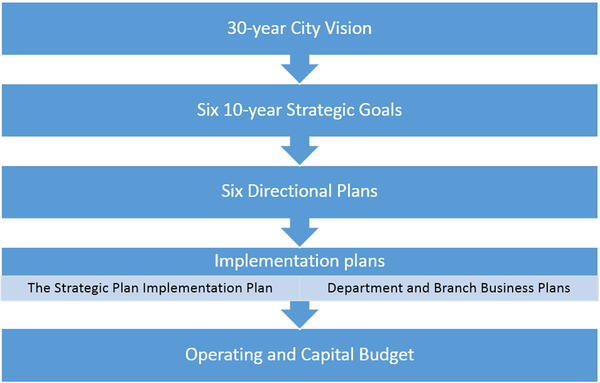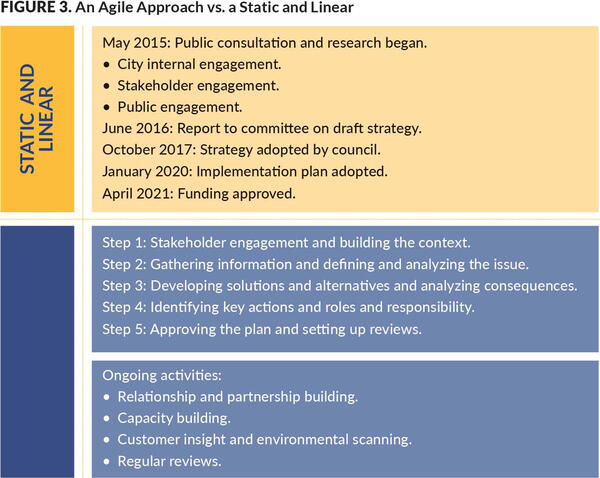
How long does it take to develop, approve, and start implementing a strategic plan (or a strategy)?
Here is the timetable of a recent example:
• May 2015: Public consultation and research began.
- City internal engagement.
- Stakeholder engagement.
- Public engagement.
• June 2016: Report to committee on draft strategy.
• October 2017: Strategy adopted by council.
• January 2020: Implementation plan adopted.
• April 2021: Funding approved.
Six years, really? As unreasonable as it may sound, this timetable and the associated linear development process represent a typical approach adopted by many organizations. In an earlier article, I mentioned that approving the strategic plan is one of the most important decisions any governing body makes, as it leads to better community engagement, prioritization, and employee engagement.1
But if it has to wait for years, it can also raise many issues, particularly in the face of the pandemic. First, the community feedback and expectations and the local context collected during the process could shift significantly, therefore the formulated strategy may no longer be valid or at least not the best approach forward. Second, there is a high risk of key personnel turnover, and therefore an increased cost of knowledge transfer and project support.
To address those issues, it comes down to the understanding that a strategic plan is also a means, not just an end: the value can come from the way we develop the plan. Based on the Agile values,2 I would like to share four principles that help improve your strategic planning process:
1. Conversations and Learning over Process
Imagine two opposite cases: on the one hand, spending too much time in discussions, so the work is delayed and timelines are not met; and on the other hand, being very efficient in managing the time, so every milestone is met, though people are not sufficiently engaged. Considering the latter case for a moment, what is the point of getting the plan approved timely, if it is at the cost of engagement, which is key to bringing a strategic plan to life?
It is crucial that you take time to understand issues and community expectations and to identify key stakeholders and foster partnership. It would be challenging to meet the timeline at first. But if we start treating the strategy as ongoing work and consider multiple plans and strategies, we will be able to leverage previous work. As a result, the required learning and effort will decrease; the efficiency will go up over time.
2. A Working Strategy over a Complex Framework and Thick Documentation
It is not uncommon to find a diagram like Figure 1 in a strategic plan. It is supposed to help communicate the structure of various plans and show how they drive decisions. It may also involve creating multiple documents, such as the implementation plan and business plans. But does it really help? The scopes and meaning are often not articulated due to limited space in the plan. It is more for internal use than for public sharing. Do we actually need it, if it is only for internal use?

A working strategy would at least include the following elements:
• Clearly articulated issues and relevant context from the community perspective.
• Good information with sound reasoning, such as the necessary research, but only including the implications with findings in the appendix or in a separate document.
• Creative solutions with alternatives, which helps frame the conversation or debate from a “yes or no” approval exercise to a choice-making exercise.
• Clearly defined consequences to the community and the organization. What is the decision? What does the approval actually mean?
• Implementation with actions and clearly defined roles and responsibilities. Commitment will be crucial.
3. Community Collaboration over a Siloed Approach
When was the last time (or ever?) has your organization or team tackled a complex issue on its own? This is what a strategy is supposed to be: coordination and consistency. Local governments play an integral role in building our community. Depending on the issue, the role would vary. It is okay for us to collaborate, to support, and to enable by focusing on shared outcomes and on where we can add the most value. Sometimes, simply understanding the issue takes multiple perspectives.
4. Responding to Change over Sticking to the Plan
The last principle is pretty self-evident. The pandemic has changed how we live, work, and play. It would be impossible for any plan to move forward without considering the pandemic’s impact on the organization and the community. In fact, the world is connected and change is constant; thus, the need to respond to change is ongoing.

To adopt the Agile approach (Figure 2) in your organization, I would like to present three suggestions:
Capacity Building
Your staff is working with community partners to understand and address the complex issues facing your community. They value every opportunity to learn and continue to build on previous conversations. They understand the rigor of a working strategy and leverage an evidence-based approach to address each of the elements. How does this sound to you? How much confidence would the council and the community have on your organization?
Well, Rome wasn’t built in a day. It takes time to develop the organization and the staff. This is why capacity building matters. As a manager, it would be essential for you to articulate expectations, delegate ownership of the work and provide resources, and continue to do so over time. Outside the administration, help the council think and act more strategically.3
Ongoing Customer Insight and Environmental Scanning
Let’s look again at the example timeline at the beginning of the article. An extraordinary amount of time and effort was spent gathering community input and research (between May 2015 and October 2017) and yet the information can quickly become obsolete in the face of uncertainty and volatility. This is where being agile can make a difference. Instead of having to conduct a one-time and in-depth engagement and research, ongoing customer insight and environmental scanning can help provide more current and sometimes even more accurate information.4 This information can be collected through multiple means:
Satisfaction survey. Does your or any organization provide services related to the issue that the strategy is set to address? If so, a satisfaction survey may suit your needs. Satisfaction surveys provide a measurement of usage and experience regarding the services provided, and can help uncover opportunities for improvement.5
Journey map. A journey map is a complete visual process from a customer’s perspective of their engagement related to the issue. Studying their interactions around the engagement points helps understand their behaviours and ultimately their needs and wants.
Focus groups and interviews. This option is more flexible and has richer details. Focus groups and interviews are a particularly useful tool for equity in terms of access to the population that is not reachable through other means, such as the people with lived experience.
Timely Review
One of the worst things you could do to the strategic plan is to get it approved and think the work is done. Sadly, this is why many strategic plans end up sitting on a shelf collecting dust. The strategic plan needs to be revisited regularly to monitor its progress and impact. Based on the criteria of the excellence category of the ICMA Certificates in Performance Management, the highest level award that recognizes best practices in performance management, tracking and consideration of data need to occur on at least a quarterly basis.
It is important for you to continue to show support to the work by voicing its importance, articulating expectations, and dedicating time and resources. Without a strong commitment from leaders, the momentum will be difficult to maintain. You can simply make the first agenda item of your leadership meeting “review progress against the strategic plan” and ask staff about the results, as well as changes in the community and the broad external environment. It sets a tone at the top, then it trickles down to the rest of the organization.

Conclusion
Just to be clear, being agile is not just about a more efficient way to create a strategic plan or any strategy. It is a community-centric approach that is based on collective impact and is more adaptive to the ever-changing world.
The four Agile values were originally created by a group of software developers to deal with the traditional waterfall software development process (very much like the static and linear strategic planning process in the timetable) that left both developers and their customers frustrated. From the FBI’s information management system to healthcare.gov, those values have proven successes to deliver projects on time and under budget.
Strategic planning would be a good example that can benefit from the Agile values in the face of a world of growing complexity at increased velocity. It comes down to your understanding that the strategic plan can also be a means of strengthening your organization and your interactions with the community. Figure 3 highlights the difference between the Agile approach and the traditional approach. Is your strategic plan a means or an end?

KEL WANG is the founder and CEO of fioh Strategy—we innovate strategy and build capacity for the public sector. He also serves on the ICMA Performance Management Advisory Committee. (kel.wang@fiohstrategy.com)
Endnotes and Resources
1 “Strategic Planning Revisited,” Kel Wang, PM magazine, August 2019.
2 The Agile Manifesto consists of four key values: individuals and interactions over processes and tools, working software over comprehensive documentation, customer collaboration over contract negotiation, and responding to change over following a plan.
3 “Building the Best Relationship with Your Council,” Kel Wang, PM magazine, February 2021.
4 Community feedback can be influenced by recent events and various media. Using multiple data helps reduce or remove this variation.
5 “Satisfying Surveys,” Kel Wang, PM magazine, March 2019.
New, Reduced Membership Dues
A new, reduced dues rate is available for CAOs/ACAOs, along with additional discounts for those in smaller communities, has been implemented. Learn more and be sure to join or renew today!
